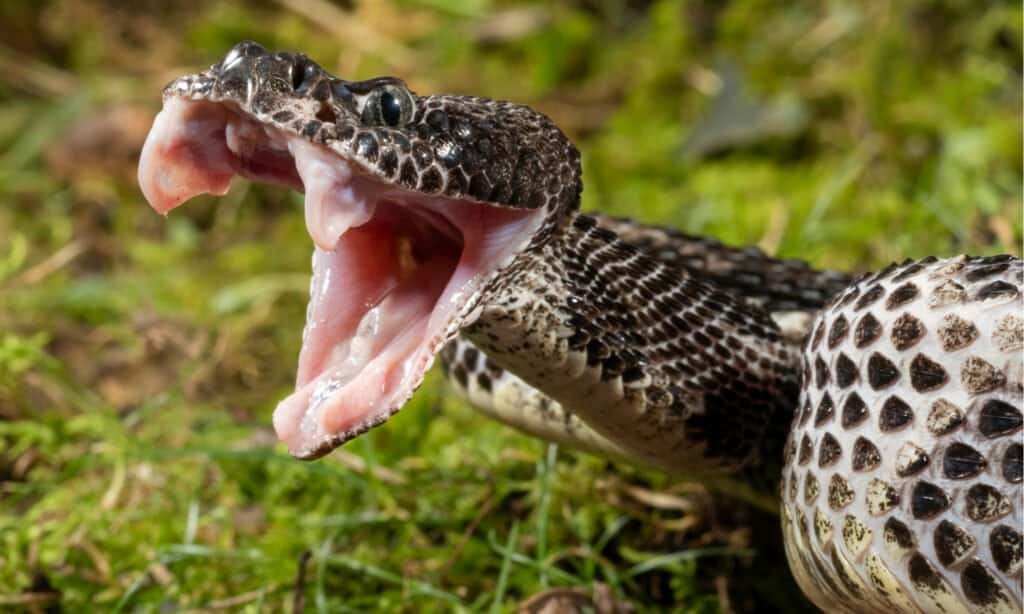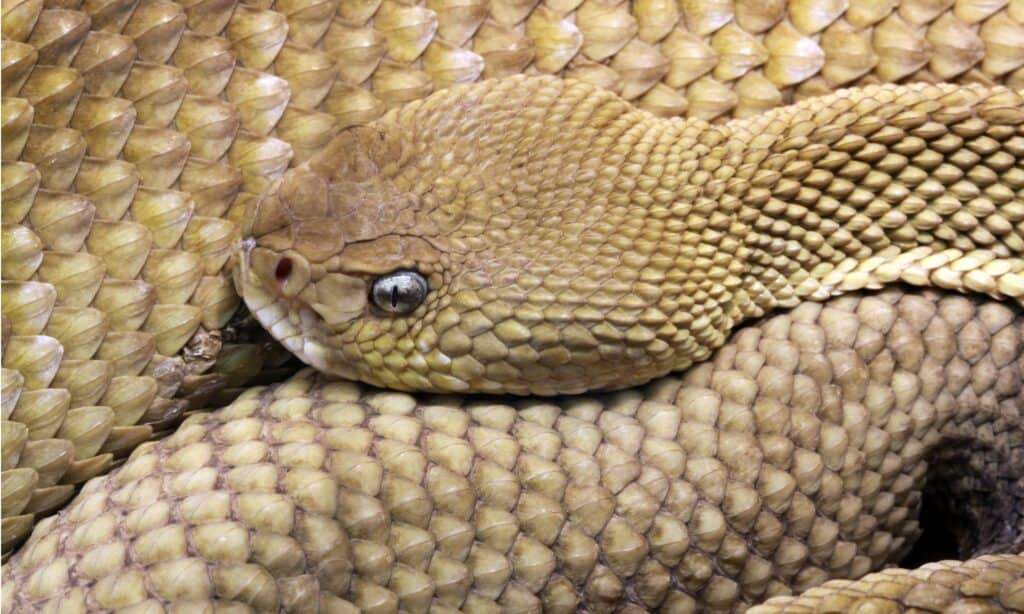Most people who have gone outdoors in the American southwest know to keep an eye out for rattlesnakes while hiking. But, would you believe that rattlesnakes actually live across the continental United States? They can be found as far north as Canada, and as far south as Argentina. They’re not just a creature of the desert, they actually live in all kinds of environments.
That’s why, if you’re planning on hiking in rattlesnake country, you should be aware of the things you can do to avoid a nasty encounter. At heart, rattlesnakes don’t want to attack people—they would much rather snack on a nice rat or gopher, but that doesn’t mean that bites don’t happen. A startled or threatened rattlesnake can be a very dangerous trail companion, particularly to dogs and children.
Here, we’ll go over where and when you should watch out for rattlesnakes. Then, we’ll talk about the five things you can do to protect yourself from these heat-sensing pit vipers when spending time outdoors. After that, we’ll go over what you should do if you happen to come upon a rattlesnake in the wild.
Habitat: Where are Rattlesnakes Found?
Rattlesnakes can be found everywhere from arid deserts to swamps and forests. There are nearly 60 total species, including timber, Mojave, and prairie rattlesnakes. They make their homes throughout the continental United States and Mexico. They’re most commonly associated with the desert southwest, though various species live throughout shrublands, grasslands, marshes, and forested areas.
5 Ways to Avoid Rattlesnakes While Hiking

By staying on trails you can avoid rattlesnakes where they blend into the habitat
©MrDinger/Shutterstock.com
The best way to avoid encountering rattlesnakes while hiking is simply to forgo hiking in peak rattlesnake season, early and late summer. But, if you would rather not spend your entire summer inside, which most of us don’t, then there are a few easy things you can do to minimize your risk of having a bad encounter with a rattlesnake.
Stay on Trail
The first, and easiest way, to avoid rattlesnakes is to stay on trail. Rattlesnakes rarely come out in the open, if they do it’s generally in the early morning hours when they first emerge to soak in the sun’s heat. Otherwise, rattlesnakes prefer to stay under bushes, or among rocks. They do this for two reasons; first, to stay out of the sight of predators, like feral pigs, kingsnakes, and roadrunners, and second, to sit in wait for prey. So, in order to avoid rattlesnakes while hiking, stay on the trail—don’t go turning over rocks and crawling under bushes.
Wear Long Pants and High Boots
It may seem like common sense, but rattlesnakes are ground dwellers and, unless you’re hiking on hands and knees, if they strike at you, they strike at your ankles or shins. Because of this, anytime you hike in rattlesnake country, it’s a good idea to wear high top boots that cover your ankles. High hiking boots don’t just protect you from snakebite, they also stabilize your ankles, and significantly reduce your chances of spraining an ankle on your hike. In addition to high-top boots, you should also wear long pants. If you’re hiking in tick country, add long sleeves to the mix for ultimate protection from both ticks and rattlesnakes.
Keep Dogs on a Leash

Keeping pets on a leash can help keep them away from dangerous rattlesnake bites.
©Joe McDonald/Shutterstock.com
Many of us take our furry companions outdoors for hikes. It’s not uncommon to see hikers with their dogs off-leash. This is generally fine, as long as the hikers are in a place that allows off-leash dogs. The one exception to this is in rattlesnake country; dogs are low to the ground and like to explore, they’re much more likely to sustain bites than humans are. So, if you think you’ll see rattlesnakes while hiking, keep your dog on a leash. You can even get a rattlesnake venom vaccine for your furry companion if you want to be extra safe.
Take a Walking Stick
Trekking poles, or walking sticks, aren’t just for serious trekkers—they’re the perfect precaution against rattlesnakes while hiking. First, you can use the pole to poke around any rocks or bushes in your way—if there’s a rattlesnake hiding in the bush, it will strike at your pole, instead of your boot.
Hike with Respect
Finally, the most important thing to remember when doing any outdoor activity is to go with respect for the natural world. This includes seeing rattlesnakes while hiking, or even hearing them. Remember, they’re wild animals, and you’re in their home. Let’s take a closer look at the steps you should take if you encounter a rattlesnake in the wild.
What to Do if You See a Rattlesnake: 3 Steps

If you see a rattlesnake move away, they typically strike when startled but will not pursue.
©Susan M Snyder/Shutterstock.com
Rattlesnakes are certainly scary, there’s no doubt about that. But, if you’re an outdoorsy person who spends a lot of time hiking, chances are good that you’ll see a rattlesnake at least once. Here are the three steps you should take if you happen across a rattlesnake on your hike.
Stop: Stay Calm
Don’t panic; don’t scream, and don’t run away. Instead, freeze, take deep breaths and stay calm. If you’re within striking distance of the rattlesnake (around three feet for adults) immediately move slowly away until you’re out of range. Do not make any sudden movements.
Do Not Approach

Never give into the temptation to verify the identity of the snake if it puts you within striking distance.
©iStock.com/Ben185
You may be tempted to move closer, either to get a closer look at the rattlesnake, or to see if it really is a rattlesnake. Don’t do this; no matter the type of snake, you should not approach it. Even if it’s not rattling; baby rattlesnakes can’t rattle, but they can still envenomate a person or pet.
Move Away
When you’re ready—though you don’t want to take too much time—start moving slowly away from the rattlesnake. Don’t worry, it won’t chase you. Rattlesnakes aren’t aggressive, and they don’t hunt people. However, they do see us as threats to their lives if we get too close to them, which is why it’s so important to move slowly, and remain calm. If you encounter a rattlesnake while hiking, treat it with respect, take only pictures (from a safe distance), and live another day to tell your rattlesnake story.
What Is The Best Time of Day To Avoid Snakes?
Temperature matters when it comes to snake sightings. Opt for hiking during the cooler times of the day, as snakes often bask in the sun to warm themselves. Choosing to hike in the evening air or colder early mornings helps you to steer clear of their preferred time for sunning.
With that said, it’s important to note that some snakes do tend to be most active during the early mornings in spring and summer seasons.
Additionally, there are some species of snakes that appear at night because that’s when their prey is most active.
Furthermore, some snakes such as coachwhips like hot temperatures and hunt small mammals such as lizards and birds that are active during the daytime hours.
The photo featured at the top of this post is © Susan M Snyder/Shutterstock.com
Discover the "Monster" Snake 5X Bigger than an Anaconda
Every day A-Z Animals sends out some of the most incredible facts in the world from our free newsletter. Want to discover the 10 most beautiful snakes in the world, a "snake island" where you're never more than 3 feet from danger, or a "monster" snake 5X larger than an anaconda? Then sign up right now and you'll start receiving our daily newsletter absolutely free.
Thank you for reading! Have some feedback for us? Contact the AZ Animals editorial team.






